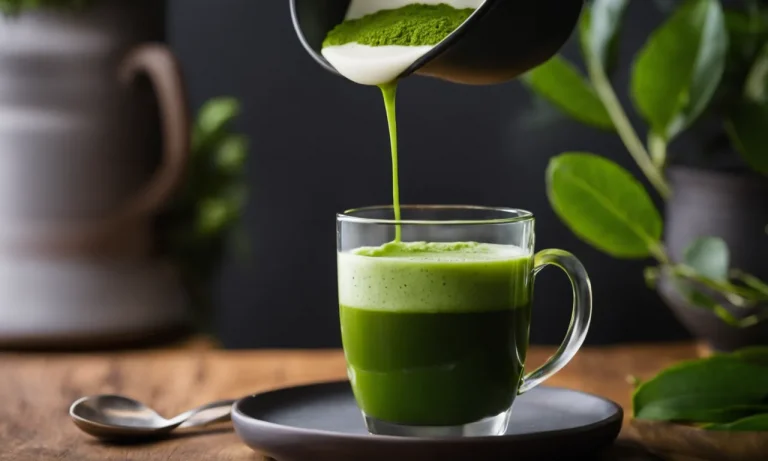If you’ve ever felt a churning in your gut after your morning Starbucks run, you’re not alone. Many coffee drinkers experience stomach discomfort from their daily dose of java.
If you’re short on time, here’s a quick answer to your question: The high acidity, caffeine content, and even ingredients like dairy and artificial sweeteners in some Starbucks drinks can irritate sensitive stomachs or trigger conditions like acid reflux or IBS.
In this comprehensive guide, we’ll dive into the reasons why Starbucks in particular may hurt your stomach, look at the ingredients to watch out for, and provide tips to enjoy your coffee without the bellyache.
What Ingredients in Starbucks Coffee Can Upset Your Stomach
While many people enjoy their daily cup of Starbucks coffee without any issues, some individuals may experience stomach discomfort after consuming it. This can be attributed to various ingredients found in Starbucks coffee that can potentially upset your stomach.
Understanding these ingredients can help you make informed choices and alleviate any discomfort you may experience.
Caffeine
Caffeine is a stimulant found in coffee that can have both positive and negative effects on the body. While it can provide a temporary energy boost and improve focus, excessive consumption of caffeine can lead to stomach irritation.
Caffeine stimulates the production of stomach acid, which can cause heartburn, acid reflux, and indigestion. If you’re sensitive to caffeine or have a pre-existing stomach condition, it’s important to moderate your intake of Starbucks coffee or opt for decaffeinated options.
Acidity
Starbucks coffee is known for its rich and bold flavors, which often come from the high acidity of the beans used. While acidity adds brightness and complexity to the taste, it can also contribute to stomach discomfort.
High acidity levels can irritate the lining of the stomach, leading to acid reflux, bloating, and stomach pain. If you’re prone to stomach issues, you may want to consider choosing Starbucks blends with lower acidity or opting for alternative brewing methods, such as cold brew or French press, which tend to be less acidic.
Dairy
Many Starbucks coffee beverages contain dairy products, such as milk or cream. While dairy can add a creamy and indulgent touch to your drink, it can also be problematic for those with lactose intolerance or dairy allergies.
Consuming dairy when you have an intolerance or allergy can result in stomach cramps, bloating, diarrhea, and other digestive issues. Starbucks offers non-dairy alternatives, such as almond milk, soy milk, and coconut milk, which can be great options for individuals with lactose intolerance or dairy allergies.
Artificial Sweeteners and Syrups
Starbucks offers a wide range of flavored syrups and sweeteners to enhance the taste of their beverages. However, some of these additives may contain artificial sweeteners, such as sucralose or aspartame, which can cause stomach upset in certain individuals.
These sweeteners are known to have laxative effects, leading to diarrhea and abdominal discomfort. If you find that artificial sweeteners or syrups in Starbucks coffee are causing stomach issues, consider choosing unsweetened options or requesting natural sweeteners like honey or agave syrup instead.
It’s important to note that everyone’s tolerance to these ingredients may vary, and what upsets one person’s stomach may not affect another’s. If you consistently experience stomach discomfort after consuming Starbucks coffee, it may be helpful to consult a healthcare professional for personalized advice.
Why Starbucks May Be Worse than Other Coffee for Sensitive Stomachs
If you have a sensitive stomach, you may have noticed that Starbucks coffee doesn’t always sit well with you. While everyone’s tolerance to coffee can vary, there are a few reasons why Starbucks coffee may be worse for sensitive stomachs compared to other brands.
Higher Caffeine Content
One of the reasons why Starbucks coffee may be harder on your stomach is its higher caffeine content. On average, a cup of Starbucks coffee contains more caffeine than other brands. This higher caffeine concentration can result in increased acid production in the stomach, leading to irritation and discomfort.
If you’re particularly sensitive to caffeine, it might be worth considering other coffee options with lower caffeine levels.
More Acidic Roast
Starbucks is known for its dark roast coffee, which tends to be more acidic compared to lighter roasts. The darker the roast, the more acidic the coffee becomes. This higher acidity can cause stomach irritation and acid reflux in individuals with sensitive stomachs.
If you find that Starbucks coffee triggers your stomach issues, you might want to explore coffee brands that offer lighter roasts, which tend to be less acidic.
Larger Drink Sizes
Another factor that may contribute to stomach discomfort is the larger drink sizes at Starbucks. Many of their standard sizes are larger than what you would typically find at other coffee shops. Consuming a larger volume of coffee can increase the likelihood of stomach irritation, especially if you have a sensitive stomach.
Consider opting for smaller sizes or diluting your coffee with water to reduce the concentration and potential impact on your stomach.
Milk and Sweetener Choices
Starbucks offers a wide variety of milk and sweetener choices to customize your coffee. However, certain milk options, such as whole milk or heavy cream, can be harder to digest for individuals with lactose intolerance or sensitive stomachs.
Additionally, artificial sweeteners used in some Starbucks beverages can also cause stomach upset in some people. If you suspect that the milk or sweetener choices at Starbucks are the culprit behind your stomach issues, try opting for alternatives like almond milk or natural sweeteners.
It’s important to note that everyone’s digestive system is different, and what works for one person may not work for another. If you consistently experience stomach discomfort after consuming Starbucks coffee, it may be worth consulting a healthcare professional to determine the underlying cause and explore potential solutions.
Tips to Enjoy Starbucks Without Stomach Pain
For many people, enjoying a cup of Starbucks coffee is a daily ritual. However, some individuals may experience stomach pain or discomfort after consuming their favorite beverage. If you find that Starbucks coffee hurts your stomach, there are a few tips you can follow to still enjoy your drink without the unwanted side effects.
Choose Low Acid Options
One reason why Starbucks coffee may cause stomach pain is its acidity. Coffee is naturally acidic, but some blends have a higher pH level than others. To minimize the impact on your stomach, opt for low acid options such as the Blonde Roast or the Veranda Blend.
These blends are known to be smoother and less likely to cause digestive distress.
Size Down
Another tip to prevent stomach pain from Starbucks coffee is to choose a smaller size. Drinking a large or venti-sized coffee can lead to an increased intake of caffeine and acidity, which may exacerbate stomach issues.
Consider ordering a tall or even a short size to reduce the amount of coffee you consume in one sitting.
Hold the Dairy
Dairy products, such as milk and cream, can irritate the stomach and worsen digestive symptoms. If you experience stomach pain after consuming Starbucks coffee, try skipping the dairy. Opt for alternative milk options like almond milk, soy milk, or oat milk.
These non-dairy alternatives are gentler on the stomach and may alleviate discomfort.
Skip the Sweeteners
Sweeteners, such as sugar or artificial sweeteners, can also contribute to stomach issues. If you find that Starbucks coffee hurts your stomach, try skipping the sweeteners altogether. You can enjoy the natural flavors of the coffee without adding any additional sugars.
If you still want a touch of sweetness, consider using natural sweeteners like honey or maple syrup in moderation.
Try Decaf or Half-Caff
Caffeine is known to stimulate the production of stomach acid, which can lead to discomfort for some individuals. If you suspect that caffeine is the culprit behind your stomach pain, consider trying decaffeinated or half-caffeinated options at Starbucks.
These options contain less caffeine and may be easier on your stomach.
Ask for an Extra Shot of Water
If you find that even the low acid and decaf options still cause stomach pain, you can ask the barista for an extra shot of water in your coffee. This will help dilute the coffee and reduce its acidity, making it gentler on your stomach.
Remember, everyone’s tolerance to coffee and its effects on the stomach is different. It’s essential to listen to your body and make adjustments accordingly. These tips can help minimize the chances of experiencing stomach pain after enjoying your favorite Starbucks coffee.
When to See a Doctor About Starbucks-Related Stomach Issues
Frequent or Severe Pain
If you find yourself experiencing frequent or severe stomach pain after consuming Starbucks coffee, it may be a sign that something more serious is going on. While occasional discomfort or mild indigestion can be normal, persistent or intense pain should not be ignored.
It could be indicative of an underlying digestive disorder or sensitivity to certain ingredients in the coffee. In such cases, it is advisable to consult a doctor to get a proper diagnosis and appropriate treatment.
Symptoms Lasting Over a Week
If your stomach issues persist for more than a week after consuming Starbucks coffee, it is time to seek medical advice. While it is common to have occasional digestive disturbances that resolve on their own, prolonged symptoms may indicate an ongoing issue that needs to be addressed.
Your doctor can help determine the cause of your symptoms and guide you towards the appropriate course of action.
Unexplained Weight Loss
If you notice unexplained weight loss along with stomach discomfort after drinking Starbucks coffee, it could be a cause for concern. Weight loss without intentional effort can be a sign of an underlying health problem, such as malabsorption or gastrointestinal disorder.
It is important to consult a healthcare professional to rule out any serious conditions and receive proper medical guidance.
Vomiting or Bloody Stool
If you experience vomiting or notice blood in your stool after consuming Starbucks coffee, it is crucial to seek immediate medical attention. These symptoms can be indicative of more serious issues, such as gastrointestinal bleeding or an allergic reaction.
Do not ignore these signs and consult a doctor as soon as possible for a thorough evaluation and appropriate treatment.
Note: While the information provided here is intended to be informative, it is important to consult a qualified healthcare professional for personalized advice. They can evaluate your specific situation and provide appropriate recommendations based on your individual needs and medical history.
The Bottom Line
The bottom line is that while Starbucks coffee may be a favorite for many people, it can cause stomach discomfort for some individuals. The high acidity and caffeine content in Starbucks coffee can lead to acid reflux, indigestion, and stomach irritation.
If you find that Starbucks coffee consistently upsets your stomach, it may be worth exploring alternative options. Here are some steps you can take to mitigate the effects of Starbucks coffee on your digestive system:
1. Opt for low-acid coffee
Starbucks offers various coffee blends with different levels of acidity. If you’re prone to stomach issues, consider trying their Blonde Roast or Decaf options, which tend to be less acidic compared to their darker roasts.
Alternatively, you can explore other coffee brands that offer low-acid options.
2. Limit your caffeine intake
Caffeine is a known irritant to the stomach lining. If you find that Starbucks coffee is causing discomfort, try switching to decaffeinated coffee or reducing your overall caffeine intake. You can also opt for other hot or cold beverages like herbal tea or fruit-infused water to satisfy your cravings.
3. Pair your coffee with food
Consuming food alongside your coffee can help reduce the impact on your stomach. Consider having a light snack or meal before or while enjoying your Starbucks coffee. This can help buffer the acidity and minimize any potential digestive issues.
4. Listen to your body
Everyone’s tolerance to coffee is different. Pay attention to how your body reacts to Starbucks coffee and adjust your consumption accordingly. If you consistently experience stomach discomfort, it may be best to explore other coffee options or consult with a healthcare professional.
Remember, these suggestions may not work for everyone, as individual sensitivities and tolerances vary. It’s important to find what works best for you and your stomach.
For more information on coffee and its effects on the digestive system, you can visit websites like Mayo Clinic or Healthline. These sources provide credible and reliable information on a wide range of health topics.
Conclusion
Starbucks may spell stomach trouble for some due to ingredients like caffeine, dairy, and artificial sweeteners. But with some simple tweaks like sizing down, choosing low acid brews, and limiting add-ins, you can enjoy your coffeehouse favorite without the bellyache.
Pay attention to any persistent issues after drinking Starbucks and see your doctor to rule out underlying conditions.






